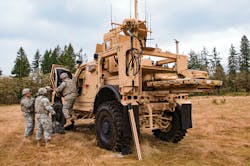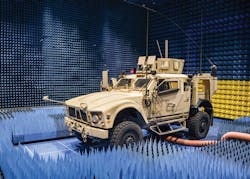The puzzle of RF co-site interference
The military relies increasingly on the RF spectrum for information throughput, sensors, and electronic warfare, yet growing demands on RF technology can cause systems in close proximity to degrade each other's signals.
BY J.R. Wilson
The modern military battlespace is overwhelmed with radio-frequency (RF) signals vying for spectrum. Even without overt RF interference from enemy jamming, radio stations nearby, or even from civilian cell phones, co-site interference has become a major problem for the U.S. military, one that is growing worse by the day. Some refer to this kind of interference as spectral friendly fire.
It can be a problem on military platforms like surface warships, land vehicles, and aircraft where many different RF transmit and receive antennas must share a relatively small space. This can be a communications nightmare in which separate RF systems inadvertently step on each other's signals, causing an RF communications fratricide problem that's only compounded by intentional or accidental RF jamming.
"Having multiple command and control (C2) capabilities on the same platform has instituted a greater awareness of how emitters perform within the same system and platform," says Chief Warrant Officer Jerome J. Foreman, senior strategic spectrum planner at the U.S. Marine Corps Command, Control, Communications, and Computers headquarters in the Pentagon.
"In the broader sense of co-located systems, the problem is even more complex due to dense areas of operations - dense in the sense of space to operate within urban populated areas - as well as the amount of spectrum-dependent systems operating within a concentrated area," Foreman says. "The requirement for multiple spectrum-dependent emitters within a system will continue to increase; therefore, it's likely that co-site interference will continue to increase, as well."
Co-site interference may be most obvious aboard a Navy ship, where growing numbers of powerful emitters and receivers crowd together on the ship's masts. It also can be seen, however, at Army and Marine Corps forward operating bases (FOBs), command and control centers, and increasingly on mobile platforms like Mine-Resistant Ambush Protected vehicles (MRAPs) and mobile communications trucks.
One of the lead agencies researching the problem for the Army is the Communications-Electronics Research, Development and Engineering Center (CERDEC) at Aberdeen Proving Ground, Md.
"Technically, it is a problem everywhere - FOBs, communications, and sensor platforms," says John Franklin, lead electronics engineer - electromagnetic interference (EMI) at the Electronic Protection and Interference Mitigation Branch of CERDEC's Space and Terrestrial Communications Directorate. "Sometimes you have to try to optimize one system over another with respect to co-site performance, but there is no consensus among users as to which is most important. You can spread things out on a FOB, but there is little latitude to change things on a platform."
Serious military challenge
"Co-site interference is a very serious challenge for all the services, varying system by system, platform by platform," Franklin continues. "There are some systems that cannot be run at the same time on the same platform. And that is becoming a bigger issue. An aircraft usually won't fly with co-site interference problems, but for the Army, there are innumerable variations, and we won't hold the fielding of a ground platform for co-site interference."
Each military service has its own labs working hard to mitigate the problem. The U.S. Defense Advanced Research Projects Agency (DARPA) in Arlington, Va., has been investigating causes and possible solutions across all services and platforms for some time. Two current programs - Advanced RF Mapping (Radio Map) and Shared Spectrum Access for Radar and Communications (SSPARC) - are headed by Joseph Evans, a DARPA Strategic Technology Office program manager.
Advanced research
"SSPARC is looking at the simultaneous operation of radars and communications devices in the same spectrum band, taking a number of different approaches," Evans says. "One looks at spectrum operations, coordinating the activities of radars and communications, motivated by increasingly agile software-defined radios [SDRs] and new technologies. Right now, it is a road with no lane lines; SDRs and radars don't need to stick within traditional boundaries - but how do we make sure we de-conflict between these devices?
"Another part asks how to define shared waveforms that do multiple things at the same time - radar and communications on the same device, waveform, and spectrum," Evans continues. "Finding solutions applicable across services is exactly the direction we're going because, looking out into the future, all those devices will be increasingly agile and capable of multiple purposes."
As the military fields more and more spectrum-dependent devices - including rapidly increasing numbers of unmanned vehicles, with more sensors and transmitters on virtually everything - higher demand for data transmission only will aggravate an already complex issue.
"That is one of our motivations for both parts of SSPARC," says DARPA's Evans. "If every small drone has a radar, you're going to need to deal with that. We're looking across the range of devices and technologies, from small UAVs [unmanned aerial vehicles] to big [Navy shipboard] Aegis radars.
"SSPARC has been running for about five years," Evans says. "Slightly before that, we started Radio Map, which is doing spectrum situational analysis. That is transitioning to the Marine Corps this summer, with joint participation by the other services, especially the Army. Those programs are helping us further evolve our capabilities, but DARPA has been working in the spectrum area for decades and has been at the forefront of the agile use of spectrum."
Radio Map is only one of several efforts Foreman says also puts the Marine Corps on the leading edge of 21st Century spectrum-dependent systems. With Radio Map, warfighters will be able to "see" the electromagnetic spectrum, similarly to looking at an infrared image of thermal patterns.
Mapping RF emissions
"The intent of this effort is to give the Marines the ability to understand how their systems are working within a spectrum-dependent co-site and co-located environment, down to the tactical edge. There is still a lot of work to be done to reach this goal, but the Marine Corps is aggressively working toward this end state," Evans says. Another vital effort, he adds, is applying military standards that lay out a system's design and how systems work together, then having the right people and tools in place to mitigate co-site interference.
"The concern, however, is when we're operating outside the parameters captured within a lab or testing facility," Evans says. "This is the question the Marine Corps is addressing through our recent Military Occupational Skill (MOS) modernization efforts. The intent is to align the right people with the right skill sets to effectively manage the electromagnetic spectrum."
In the past quarter-century, the world has seen an almost exponential growth in spectrum needs as military and civil end users seek to connect voice, text, graphics, imagery, and full-motion video communications. This will create demand for terabytes (soon perhaps petabytes) of RF throughput for sensor data, radars, jammers, and more.
With so many different systems competing for spectrum, they can tolerate only so much interference before their performance degrades, notes Alex Lackpour, senior RF spectrum research engineer at Lockheed Martin Advanced Technology Laboratories (ATL) in Cherry Hill, N.J.
"You have high-power emitters operating in the presence of very sensitive receivers, which increases the challenge; there is only so much room for techniques, such as positioning the antennas to increase RF isolation between the transmitter of one and the receiver of another, or changing orientation of an antenna so the EM fields are not coupling with each other or using cross-polarization. But on a platform, there are challenges to make everything fit and operate together simultaneously. We don't want to have to turn off systems; that's not a good solution," Lackpour says.
Among the first efforts to mitigate co-site interference was the use of better power control, radio front-end filtering, and better planning - starting at the initial design phase of new systems. While more can be done in all three, they are not enough to solve the military's problems as experts seek to maintain the U.S. technological advantage in battle.
The role of cognitive radio
"A key feature of system planning is the trend toward cognitive radio and dynamic spectrum access," says Brian Sadler, senior scientist of intelligent systems at the Army Research Laboratory (ARL) in Adelphi, Md. "Full-duplex means being able to receive and transmit at the same time on the same frequency. The commercial state of the art is sending and receiving simultaneously on different bands. There is a sizeable investment commercially in using the same frequency."
RF technology developers are struggling to keep pace with new trends in how the military uses the RF spectrum. "We are building more intelligence into radios," Sadler says. "Cognitive radio now has a sensing capability and can scan the spectrum of interest. Dynamic spectrum access specifically refers to the dynamic-access use and reuse of spectrum among users and across different systems so they can coexist and we get a lot better use of the spectrum we have."
The tight spacing of massive radars, communications systems, and other electronic gear on a modern naval vessel might seem to make the maritime environment the most vulnerable to co-site interference. It might be ground forces, however, that actually may face the greatest obstacles.
"There are problems in both domains, with good news and bad in each," says the Army's Sadler. "The Navy has a lot of high-power devices on one large platform, but also controls everything about that platform, such as spacing of antennas and their orientation. The Army is totally beholden to how we're operating at the moment as far as spacing of soldiers and vehicles and how many nodes are close by. The propagation environment also varies dramatically depending on where we are operating.
"There are component technologies that can be adapted across the services, down to the component level on radios, antennas, or how you code waveforms," Sadler says. "This extends up to system levels on things such as access protocols for sharing spectrum. Are there overlaps and common technologies and learning from each other? Absolutely."
Civilian technology
Spectrum interference isn't strictly a military problem, with some possible solutions coming from civilian applications.
"The same thing is happening wherever people are trying to pack more users into a tight spectrum, including the commercial world," Sadler says. "But they have the advantage of fixed infrastructure and centralized management in the case of cellular and smart thinking on Wi-Fi. There is a lot of research in the commercial world on how to continuously improve infrastructure and work across bands, such as Wi-Fi, Bluetooth, and cellular co-existing in the same device. The military will follow those trends as we deal with using multiple systems in the same device.
"There are quite a few pieces of technology that potentially can feed into good system designs in the future," Sadler continues. "That ranges from traditional things -antennas and filters - to more exotic technologies, such as same frequency full-duplex, which is coming along commercially and being looked at by the military."
The current state of the art in co-site interference mitigation is advanced modeling and simulation during the design phase of new systems and components to study how much coupling and interference will occur, based on known operational or test data, says Lockheed Martin's Lackpour.
With an approach like this, "by the time you field it, you have a pretty good idea of what you need to do to address this problem than if you try to retrofit at a later time," Lackpour adds. "We want to have more RF systems - sensors or comms links, more networking, more situational awareness - flowing between all the platforms. That increases the need for spectrum, putting even more stress and strain on the co-site interference problem as our future operations develop new methods using new equipment."
Many experts are watching the commercial RF industry closely to determine which commercial technologies they can harvest for military use.
Government regulations
"Another part of my research is understanding what is going on in the commercial world," points out Lockheed Martin's Lackpour. He's looking into spectral encroachment, where the U.S. Federal Communications Commission (FCC) has taken some dedicated spectrum from the military, and shared it with commercial or civilian users. Some military systems also have problems with spectrum licensed to commercial users in other countries.
"That is not co-site interference, but spectral encroachment, in the U.S. and in other parts of the world, but it leaves less spectrum available to the military, so all our spectrum needs must be further compressed," Lackpour says.
Future developments in resolving co-site interference will require a combination of hardware and software technologies; implementation of standards; greater commonality of systems across services, including allied militaries; more accurate modeling and simulation, from initial design to fielding; more research to better understand and use available spectrum; increasing the dynamic range of receivers so they can better tolerate strong co-channel interference; improved tunable analog filters; development of agile frequency filters; and continued efforts to perfect simultaneous transmit and receive technology on the same frequency with a large dynamic range, possibly using a beam-forming array.
"That's device technology, at the system level," Lackpour says. "At the platform level, instead of having a human manually install, configure, and adjust the co-site interference mechanisms, you would have an automatic system take over to automatically drive that adaptation."
This is where computer-based artificial intelligence (AI) likely will come into play. "There is a lesser version that adapts based on rules, but an engineer in the lab cannot possibly write out all the rules where a system will operate because there are just too many combinations of variables in the real world," Lackpour says. "Further into the future, we can imagine AI driving that adaptation and learning on its own, based on performance of the various systems and what does and does not work. So you have all the degrees of freedom you've built into the various systems, plus AI enabling co-site interference mitigation and mission success in general."
Artificial intelligence
As with every other potential application, AI is subject to many definitions and constraints, but the speed at which spectrum conflict already occurs eclipses human response time, especially with the continued growth of software-defined (SD) systems and components.
Software-defined systems "are definitely a key to the solution, but it is a double-edged sword; agility brings new capabilities, but also new challenges," says DARPA's Evans. "It really is a new world in terms of the ability to be agile in the spectrum, but that brings a need for more agile allocation than the traditional static allocation we've had for about a century now.
"The decision times on being agile in the spectrum are getting very short, so increasing automation is required," Evans continues. "I view AI as one of the technologies that can be applied in this space, but there are several adaptive technologies, including simple optimization techniques, and neural networks."
Anything that is not software-defined now will be in the future, predicts Lockheed Martin's Lackpour. "Non-SD systems may be fast and economical, but are not flexible," he says. "When you move to software-defined RF, you introduce the ability for the system to understand its environment and adapt its configuration to function better. In the case of co-site interference mitigation, it opens a tremendous freedom to use different frequencies or change transmission characteristics to minimize interference."
Modeling and simulation at the design level, software-defined systems, and artificial intelligence are the three technologies with the strongest potential in the future, Lackpour says. "Any fielded system also will be using, in the early stages of its design, all the different domains of modeling and simulation, which, if done right, reduces cost and improves the success of the design over time. Once fielded, software-defined RF systems and AI will be part of those systems in the future."
Political challenges
There also is a non-technical chal- lenge in mitigating co-site interference: government bureaucracy.
"The biggest problem the Army has is in the acquisition process, which is very stove-piped," says CERDEC's Franklin. "You may have one program manager buying radio A and another buying radio B and there can be a lot of issues when you come up with an interference solution because no one claims ownership of the fix. Another big piece is expectations management. There's not a lot of understanding about integrating two radios on the same platform, such as how closely in proximity and frequency should they operate or what is the acceptable degradation between them if operating at the same time."
Those managing military RF programs should give more thought up-front to how similar systems can work together with a minimum of interference, Franklin says. "It's a very misunderstood topic. The problems are getting worse and as we start to incorporate more and more COTS or non-developmental items into our systems, we really need to think about whether they were ever designed to work around a bunch of 50-watt transmitters. Sometimes if you put communications systems in an electromagnetic environment, you can see interference off the device itself, not necessarily between two systems radiating over the air. You have to be careful what EM environment these COTS [commercial off-the-shelf] components will be asked to work in."
DARPA, which takes the longest view into the future, anticipates a similar line of development, but takes perhaps a stronger position than others on leveraging the commercial world at speeds the military could never match.
"In general, what we've been trying to do is make sure the types of technologies we're working on leverage commercial developments," DARPA's Evans says. "The trend in the spectrum area we are most focused on is dealing with the proliferation of RF devices and the coordination of all those functions that will be increasingly common.
"The problem will only grow for spectrum use and we're looking for technologies to address that," Evans says. "We're definitely looking at the issue of deconfliction between devices and view it as an increasingly urgent problem. We are continuing to try to push the technology as far to the edge as we can and believe there are still some great opportunities."
Co-existence in the electromagnetic spectrum has grown from a theoretical exercise to a major key to combat victory in less than two decades - from spectral leakage due to power mismatch to a recent effort to co-locate sensitive directional radars and powerful radios using the same band.
"We are getting smarter and smarter about how we are using spectrum, but it is important to note that this kind of sensing and adapting also implies potential vulnerabilities, a serious security aspect that doesn't really arise in the commercial space," says the Army's Sadler.
"Managing everything together is a significant challenge. As soon as you allow adaptive or cognitive to handle co-site interference, it's really hard to manage those policies," Sadler says. "And when you add on the security issues, we have to be very smart and careful about how we design these things.
"We hope we can bring autonomy to the table in a way that will empower our networks - call it autonomous networking," Sadler says. "The real problem is we don't have a fixed infrastructure or centralized manager with massive computing power to control all the user access.
"The hope is this emerging blend of autonomous and cognitive networking will provide real leap-ahead technology where we have struggled for years," Sadler continues. "But it's still a research question, not something the development centers are embarked on in a wholesale way."




